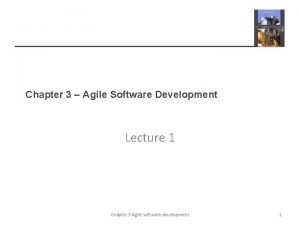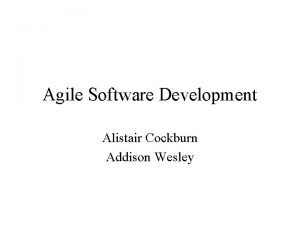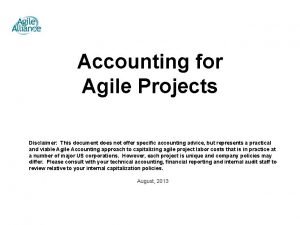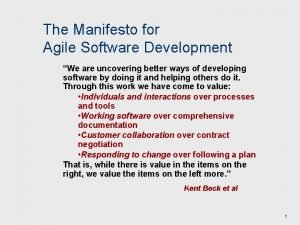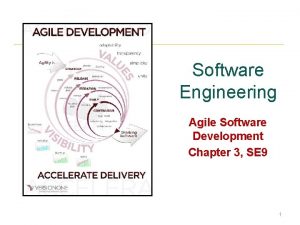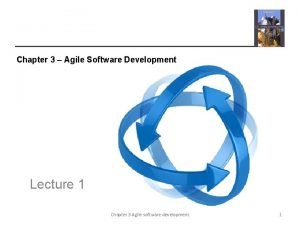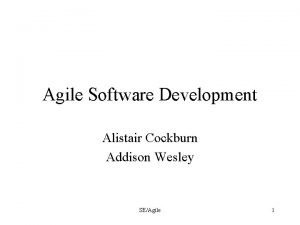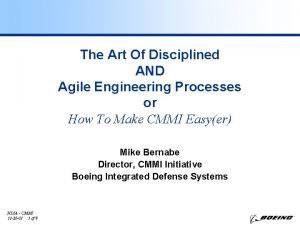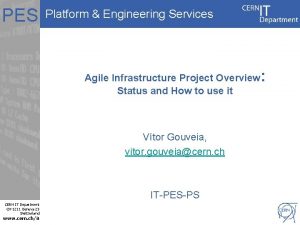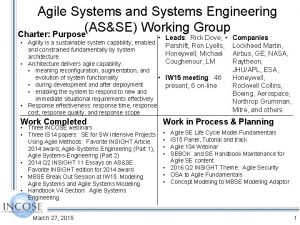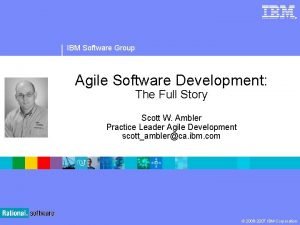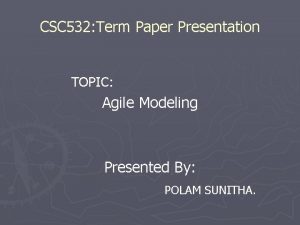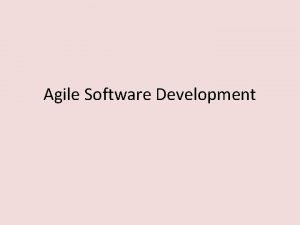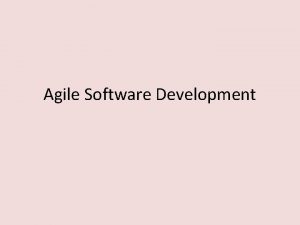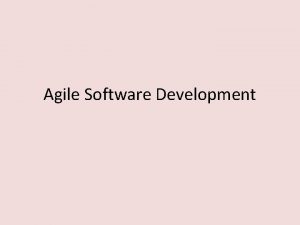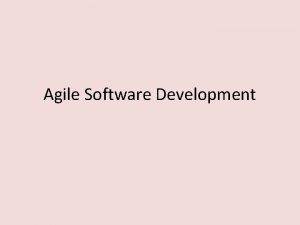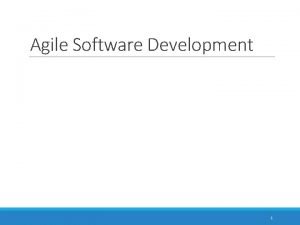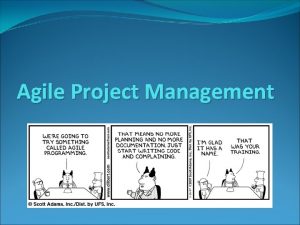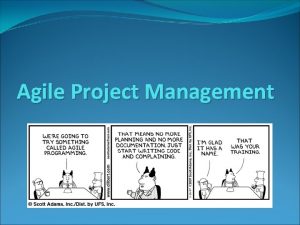Software Engineering Lecture 7 Agile Software Development Lecture





















- Slides: 21

Software Engineering Lecture 7 Agile Software Development Lecture # 7 Fahim Khan Assistant Professor of Computer Science UOL, Sargodha fahim. khan@iiu. edu. pk

Agile Development • What is it? - Agile SE combines philosophy and a set of developing guidelines. - Philosophy encourages customer satisfaction and early incremental delivery of software. • Who does it? - Off course Software engineers and other project stakeholders (managers, customers and users) work together on an agile team. - self organizing and in control of its own destiny. • Why it is important? - It is a reasonable alternative to conventional software engineering for certain classes of software and certain types of software projects. - Deliver successful systems quickly.

Agile Development • What are the steps? - Communication, planning, modeling, construction, and deployment. • What is the work product? - Strongly focused on Operational “software increment”, which must be delivered to the customer on the appropriate commitment date. • How do I ensure that I have done it right? - Software increments must satisfy the customers needs, because it was delivered to customer after agile team satisfaction.

Rapid software development • Rapid development and delivery is now often the most important requirement for software systems: – Businesses operate in a fast. – Changing requirement and it is practically impossible to produce a set of stable software requirements – Software has to evolve quickly to reflect changing business needs. • Rapid software development – Specification, design and implementation are inter-leaved – System is developed as a series of versions with stakeholders involved in version evaluation – User interfaces are often developed using an IDE and graphical toolset.

Agile methods • Dissatisfaction with the overheads involved in software design methods of the 1980 s and 1990 s led to the creation of agile methods. These methods: – Focus on the code rather than the design – Are based on an iterative approach to software development – Are intended to deliver working software quickly and evolve this quickly to meet changing requirements. • The aim of agile methods is to reduce overheads in the software process (e. g. by limiting documentation) and to be able to respond quickly to changing requirements without excessive rework.

Agile manifesto • An emerging political movement, one that attacks the old guard and suggests revolutionary change. • We are uncovering better ways of developing software by doing it and helping others do it. Through this work we have come to value: – – Individuals and interactions over processes and tools Working software over comprehensive documentation Customer collaboration over contract negotiation Responding to change over following a plan • That is, while there is value in the items on the right, we value the items on the left more.

What is Agility? • An agile team is a quick team able to appropriately respond to changes. • Change is what software development is very much about. - changing in software building - changes to the team members - changes because of new technology - changes of all kinds which have a direct impact on the product. • An agile team recognizes that software is developed by individuals working in teams and that the skills of these people, their ability to collaborate is at the core fro the success of the project. • Agility is more than effective response to change. • It encourages team structures and attitudes that make communication among members, b/w technologists and business people, b/w software engineers and their managers more easy.

What is Agility? Effective (rapid and adaptive) response to change Effective communication among all stakeholders Drawing the customer onto the team Organizing a team so that it is in control of the work performed Yielding … • Rapid, incremental delivery of software • •

An Agile Process • Is driven by customer descriptions of what is required (scenarios) • Recognizes that plans are short-lived • Develops software iteratively with a heavy emphasis on construction activities • Delivers multiple ‘software increments’ • Adapts as changes occur 9

Agile Process • It is characterized in a manner that address the key assumptions about the majority of software projects: - difficult to predict in advance that, which software requirements will persist and which will change. ( difficult to predict about change in customer priorities when the project is proceeds). - For multiple projects, design and construction are interleaved. i. e. , both the activities should be perform in cycle so that the design models are proven as that are created. - but it is very difficult to predict, that how much design is necessary before construction. - Analysis, design, construction and testing are not as predictable ( from a planning point of view) as we might like. • How to create a process that ca manage Unpredictability? - we can achieve unpredictability by using an agile process. - an agile software process must be adopted incrementally.

Agility Principles • Agile alliance defines 12 principles for those who want to achieve agility: - Satisfy the customer through early and continuous delivery of valuable software. - always welcome change in software prototype, even late in development. - Always deliver working software frequently, from a couple of weeks to couple of months, with the preference to the shorter timescale. - developers and business people work together daily throughout the project. - The project must be build by motivated individuals, provide them a good environment and support to them. - Allow them face to face communication. - At regular intervals, the team reflects on how to become more effective, then tunes and adjust its behavior accordingly.

The principles of agile methods Principle Description Customer involvement Customers should be closely involved throughout the development process. Their role is provide and prioritize new system requirements and to evaluate the iterations of the system. Incremental delivery The software is developed in increments with the customer specifying the requirements to be included in each increment. People not process The skills of the development team should be recognized and exploited. Team members should be left to develop their own ways of working without prescriptive processes. Embrace change Expect the system requirements to change and so design the system to accommodate these changes. Maintain simplicity Focus on simplicity in both the software being developed and in the development process. Wherever possible, actively work to eliminate complexity from the system.

Human Factors • Proponents of agile software development take great pains to emphasize the importance of “people factors”. • Cockburn and Highsmith et al, states that, “Agile development focuses on the talents and skills of individuals, molding the process to specific people and teams”. Competence: - inborn talent, software-related skills and overall knowledge of the process. Common Focus: - all the team members must focus on one goal, to deliver a working software increment to the customer within the time promised. they achieved this goal and will also focus on continual adaptations (small or large), which make the process fit to the needs of the team. Collaboration: - they must collaborate with each other and also to other stake holders while creating information, helping them to perform the required task. Decision-Making Ability: - team have the freedom to control its own destiny. The team must be autonomous while taking decision- making. Etc. .

Agile method applicability • Product development where a software company is developing a small or mediumsized product for sale. • Custom system development within an organization, where there is a clear commitment from the customer to become involved in the development process and where there are not a lot of external rules and regulations that affect the software. • Because of their focus on small, tightly-integrated teams, there are problems in scaling agile methods to large systems.

Problems with agile methods • It can be difficult to keep the interest of customers who are involved in the process. • Team members may be unsuited to the intense involvement that characterizes agile methods. • Prioritizing changes can be difficult where there are multiple stakeholders. • Maintaining simplicity requires extra work. • Contracts may be a problem as with other approaches to iterative development.

Agile methods and software maintenance • Most organizations spend more on maintaining existing software than they do on new software development. So, if agile methods are to be successful, they have to support maintenance as well as original development. • Two key issues: – Are systems that are developed using an agile approach maintainable, given the emphasis in the development process of minimizing formal documentation? – Can agile methods be used effectively for evolving a system in response to customer change requests? • Problems may arise if original development team cannot be maintained.

Plan-driven and agile development • Plan-driven development: – A plan-driven approach to software engineering is based around separate development stages with the outputs to be produced at each of these stages planned in advance. – Not necessarily waterfall model – plan-driven, incremental development is possible – Iteration occurs within activities. • Agile development – Specification, design, implementation and testing are inter-leaved and the outputs from the development process are decided through a process of negotiation during the software development process.

Plan-driven and agile specification

Technical, human, organizational issues • Most projects include elements of plan-driven and agile processes. Deciding on the balance depends on: – Is it important to have a very detailed specification and design before moving to implementation? If so, you probably need to use a plan-driven approach. – Is an incremental delivery strategy, where you deliver the software to customers and get rapid feedback from them, realistic? If so, consider using agile methods. – How large is the system that is being developed? Agile methods are most effective when the system can be developed with a small co-located team who can communicate informally. – This may not be possible for large systems that require larger development teams so a plan-driven approach may have to be used.

Technical, human, organizational issues – What type of system is being developed? • Plan-driven approaches may be required for systems that require a lot of analysis before implementation (e. g. real-time system with complex timing requirements). – What is the expected system lifetime? • Long-lifetime systems may require more design documentation to communicate the original intentions of the system developers to the support team. – What technologies are available to support system development? • Agile methods rely on good tools to keep track of an evolving design – How is the development team organized? • If the development team is distributed or if part of the development is being outsourced, then you may need to develop design documents to communicate across the development teams.

Technical, human, organizational issues – Are there cultural or organizational issues that may affect the system development? • Traditional engineering organizations have a culture of plan-based development, as this is the norm in engineering. – How good are the designers and programmers in the development team? • It is sometimes argued that agile methods require higher skill levels than plan-based approaches in which programmers simply translate a detailed design into code. – Is the system subject to external regulation? • If a system has to be approved by an external regulator (e. g. the FAA approve software that is critical to the operation of an aircraft) then you will probably be required to produce detailed documentation as part of the system safety case.
 Agile view of process in software engineering
Agile view of process in software engineering Msf process model
Msf process model Chapter 3 agile software development
Chapter 3 agile software development Agile methods for embedded systems development
Agile methods for embedded systems development Rock climbing cockburn
Rock climbing cockburn Accounting for agile software development
Accounting for agile software development The manifesto for agile software development
The manifesto for agile software development Iso 9001 agile software development
Iso 9001 agile software development Chapter 3 agile software development
Chapter 3 agile software development Chapter 3 agile software development
Chapter 3 agile software development Seagile
Seagile Requirement analysis in software engineering notes
Requirement analysis in software engineering notes Agile engineering processes
Agile engineering processes Agile ibm continuous engineering
Agile ibm continuous engineering Agile engineering services
Agile engineering services Agile systems engineering
Agile systems engineering What is system in software engineering
What is system in software engineering Forward engineering and reverse engineering
Forward engineering and reverse engineering Ibm agile development
Ibm agile development Agile dilbert
Agile dilbert Agile model driven development amdd
Agile model driven development amdd Agile game development with scrum
Agile game development with scrum


